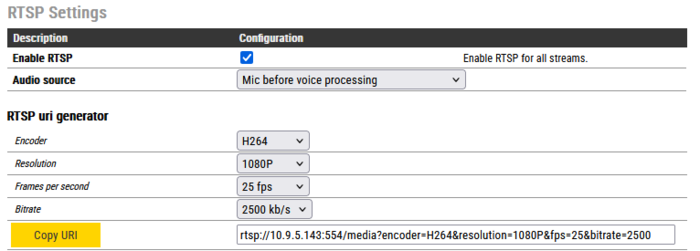Difference between revisions of "RTSP Settings"
From Zenitel Wiki
(→Audio Streaming) |
|||
| (8 intermediate revisions by the same user not shown) | |||
| Line 1: | Line 1: | ||
{{AEIS}} | {{AEIS}} | ||
| − | '''Real Time Streaming Protocol (RTSP)''' is a network control protocol designed for use in entertainment and communications systems to control streaming media servers. | + | '''Real Time Streaming Protocol (RTSP)''' is a network control protocol designed for use in entertainment and communications systems to control streaming media servers. Zenitel devices support RTSP version 1.0 defined in [https://tools.ietf.org/html/rfc2326 RFC 2326].<br> |
| − | + | ||
| + | RTSP audio streaming is supported on all devices. In addition video streaming is supported on devices with camera. | ||
== Software requirements == | == Software requirements == | ||
| Line 18: | Line 19: | ||
<br style="clear:both;" /> | <br style="clear:both;" /> | ||
| − | '''Audio source''' - defines what audio signals to send out on the RTSP stream. You can choose whether only the microphone signal is sent to the RTSP stream or both microphone and speaker signals are sent | + | '''Audio source''' - defines what audio signals to send out on the RTSP stream. You can choose whether only the microphone signal is sent to the RTSP stream or both microphone and speaker signals are sent out on the RTSP stream. Options are: |
| − | * '''Mic before voice processing''' - Both microphone and speaker signals are sent out to the RTSP stream. The mixing is by acoustic coupling between loudspeaker and microphone. | + | * '''Mic before voice processing (AEC)''' - Both microphone and speaker signals are sent out to the RTSP stream. The mixing is by acoustic coupling between loudspeaker and microphone. |
| − | * '''Mic after voice processing + far end audio''' - Both microphone and speaker signals are sent out to the RTSP stream. The mixing of the loudspeaker and microphone is done electronically. | + | * '''Mic after voice processing + far end audio''' - Both microphone and speaker signals are sent out to the RTSP stream. The mixing of the loudspeaker and microphone signals is done electronically. (Option available as from version 9.0.3.0.) |
| − | + | * '''Mic after voice processing (AEC)''' - Only microphone signal is sent out to the RTSP stream. | |
| − | |||
| − | |||
| − | |||
| − | |||
| − | |||
| − | |||
| − | |||
| − | |||
<br> | <br> | ||
| Line 49: | Line 42: | ||
Click the '''Copy URI''' button to copy the generated URI to the clipboard of your laptop. | Click the '''Copy URI''' button to copy the generated URI to the clipboard of your laptop. | ||
| − | [[Image:RTSP Settings | + | [[Image:RTSP Settings Video2.PNG|thumb|left|700px|RTSP settings - Video intercom]] |
<br style="clear:both;" /> | <br style="clear:both;" /> | ||
Latest revision as of 16:08, 27 September 2024
Real Time Streaming Protocol (RTSP) is a network control protocol designed for use in entertainment and communications systems to control streaming media servers. Zenitel devices support RTSP version 1.0 defined in RFC 2326.
RTSP audio streaming is supported on all devices. In addition video streaming is supported on devices with camera.
Contents
Software requirements
RTSP streaming is supported as from Turbine software version 4.11
Authentication
Authentication is required.
The username and password of the device must be included in the url, e.g.: rtsp://<username>:<password>@10.5.102.106:554...
- Example: rtsp://admin:alphaadmin@10.5.102.106:554/media/
Audio Streaming
Configuration of Audio Streaming from Non-video intercom devices is done from the RTSP and ONVIF menu in the web interface of the device:
Audio source - defines what audio signals to send out on the RTSP stream. You can choose whether only the microphone signal is sent to the RTSP stream or both microphone and speaker signals are sent out on the RTSP stream. Options are:
- Mic before voice processing (AEC) - Both microphone and speaker signals are sent out to the RTSP stream. The mixing is by acoustic coupling between loudspeaker and microphone.
- Mic after voice processing + far end audio - Both microphone and speaker signals are sent out to the RTSP stream. The mixing of the loudspeaker and microphone signals is done electronically. (Option available as from version 9.0.3.0.)
- Mic after voice processing (AEC) - Only microphone signal is sent out to the RTSP stream.
Audio and Video Streaming
Default RTSP url
The URL used for Audio and Video Streaming from a Video intercom device is displayed in the Video Settings menu:
RTSP url generator
An RTSP url generator is available from the Advanced Video Settings menu. The RTSP url generator allows to configure and use custom RTSP url. The custom RTSP url can be used in parallel with the default RTSP url, but will have a different configuration than the default one
- Encoder - which encoder will be used for the video stream, options are H264 and MJPEG
- Resolution - Sets the pixel resolution, options are. Supports 240p, 480p, 720p (H264 only) and 1080p (H264 only).
- Frames per second - sets the framerate per second. Options are 5fps, 10fps, 15fps (H264 only) , 25fps (H264 only) and 30fps (H264 only)
- Bitrate (H264 only) - Sets the bitrate which will be used in video stream. Options are 128, 300, 500, 1000, 1500, 2500, 5000 and 7000kb/s
Click the Copy URI button to copy the generated URI to the clipboard of your laptop.




